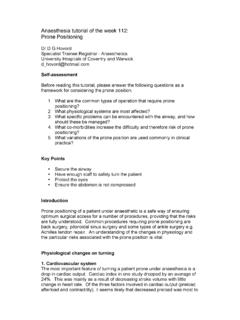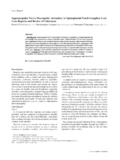Transcription of 258 Peripheral Nerve Injuries and Positioning for …
1 Sign up to receive ATOTW weekly - email Peripheral Nerve Injuries AND. Positioning FOR GENERAL anaesthesia . anaesthesia TUTORIAL OF THE WEEK 258. 7TH MAY 2012. Dr Katrina Webster Royal Hobart Hospital, Australia Correspondence to QUESTIONS. Before continuing, try to answer the following questions. The answers can be found at the end of the article, together with an explanation. 1. Which is the most common Nerve that is injured perioperatively? 2. Which of the following Nerve Injuries is least avoidable, even with ideal Positioning ? a. Lateral femoral cutaneous Nerve b. Brachial plexus c. Ulnar Nerve d. Sciatic Nerve 3. Which of the following groups has the best prognosis after Nerve injury (Sneddon's classification)?
2 A. Neurapraxia b. Axonotmesis c. Neurotmesis INTRODUCTION. Perioperative Peripheral Nerve Injuries (PPNI) are a common and potentially catastrophic complication of anaesthesia and surgery. These Injuries include a range of morbidity from transient and clinically minor injury, through to severe permanent injury. The ASA Closed Claims Project database, which was commenced in 1985, is an important source of information about perioperative Nerve injury. Closed claims analysis has shown that Peripheral Nerve Injuries are a consistently common cause of litigation claims against anaesthetists, comprising 16% of claims1. Nerve injury was the second most common claim in the entire database.
3 Incidence of Nerve Injuries The exact incidence is difficult to determine, and underreporting of Nerve injury complications is likely. Retrospective studies have found that the incidence of permanent Nerve damage after a surgical procedure and anaesthesia is to Some of these retrospective studies have included patients who received neuraxial blockade or regional anaesthetic techniques, while others have excluded them. Regional and neuraxial techniques may slightly increase the incidence of permanent Nerve damage, however this has not been well demonstrated. ATOTW 258 Peripheral Nerve Injuries and Positioning for anaesthesia , 07/05/12 Page 1 of 8. Sign up to receive ATOTW weekly - email Commonly injured nerves include the ulnar Nerve (28%), brachial plexus (20%), lumbosacral root (16%), and spinal cord (13%).
4 Injury is less common for the sciatic, median, radial and femoral nerves. Many cases of Nerve damage have no identifiable mechanism of Nerve injury, such as in 91% of ulnar Nerve Injuries . While causative factors in PPNI can be multi-factorial, optimum Positioning of surgical patients is helpful to reduce the risk of patient harm. This article will focus on perioperative injury to Peripheral nerves and discuss methods to reduce the risk of Nerve injury occurring. CLINICAL FEATURES AND DIAGNOSIS Onset Onset of neuropathy symptoms can occur rapidly (within hours) or may be delayed several weeks after the initial insult. Rapid onset of neuropathy is more likely to be direct Nerve injury.
5 Delayed onset symptoms are suggestive of tissue inflammation or swelling as a cause. Character of symptoms and signs Symptoms can involve sensory and/or motor loss. This may include anaesthesia , paraesthesia, hypaesthesia, hyperaesthesia, and pain. Disabling autonomic dysfunction can occur and chronic regional pain syndrome may develop. Severe cases may lead to muscle wasting, joint dysfunction and bone weakness. Significance of the injury This varies greatly and depends on the nature of the symptoms, the extent of the injury as well as the impact on daily life for the patient. For example, motor weakness of the dominant hand of a young carpenter with a family to support is likely to have a different impact when compared to the same injury in a retired elderly patient.
6 PATHOPHYSIOLOGY The Peripheral Nerve consists of a cell body and an axon. The Nerve axon is wrapped in Schwann cells, which form the myelin sheath of the cell. The Schwann cells are surrounded by endoneurium, which forms a continuous protective cover along the length of the individual Nerve cell. Collections of Nerve fibres are surrounded by a layer of connective tissue, called the perineurium. There is an outer layer of connective tissue which collects all the Nerve fibre bundles together to form a Peripheral Nerve . This outermost tissue layer is called the epineurium. Injury to the myelin sheath or axon of a Nerve can lead to focal conduction block, degeneration and demyelination.
7 CLASSIFICATION OF Nerve INJURY. Seddon's classification Seddon's classification system divides Nerve injury into three groups based on the Nerve pathology. Neurapraxia: damaged myelin with intact axon. Impulse conduction across the affected segment fails. Mild and reversible Nerve injury. Recovery usually occurs in weeks to months and prognosis is good. Axonotmesis: axonal disruption. Endoneurium and other supporting connective tissue are preserved. Recovery and prognosis is variable. Neurotmesis: Nerve is completely severed. There is complete destruction of all supporting connective tissue structures. Surgery may be required and prognosis is poor. ATOTW 258 Peripheral Nerve Injuries and Positioning for anaesthesia , 07/05/12 Page 2 of 8.
8 Sign up to receive ATOTW weekly - email Sunderland's classification Sunderland's classification system has five groups based on which connective tissue components are disrupted. Type 1: Local myelin injury (equivalent to Seddon's neurapraxia' group). Recovery in weeks to months. Good prognosis. Type 2: Disruption of axonal continuity with Wallerian degeneration. Regeneration of axon required for recovery. Good prognosis. Type 3: Loss of axonal continuity and endoneurial tubes. Perineurium and epineurium preserved. Scarring can compromise recovery. Guarded prognosis. Surgery may be required. Type 4: Loss of axonal continuity, endoneurial tubes and perineurium damaged. Epineurium remains intact.
9 Poor prognosis. Surgery necessary. Type 5: Nerve entirely severed (equivalent to Seddon's neurotmesis' group). Surgery required. Prognosis poor. PREDISPOSING FACTORS Patient factors Thin or obese body habitus Old age History of vascular disease, diabetes, smoking Male gender Hypotension, hypovolaemia, dehydration Coagulopathy or presence of haematoma near Nerve Infection/presence of abscess near Nerve Pre-existing generalized neuropathy Hereditary predisposition Structural anomaly/congenital abnormality (eg. constriction at thoracic outlet or condylar groove, or arthritic narrowing of joint space). Hypothermia (there is a high incidence of Nerve injury after induced hypothermia).
10 Surgical factors The type of surgery is probably the single most important risk factor in PPNI. Surgery involves the use of needles, sutures, retractors, diathermy and scalpels, which can cause damage to nerves. The highest risk of Nerve injury occurs with neurosurgery, cardiac surgery, general surgery and orthopaedic surgery. Risk is higher when surgery involves tourniquet use and tight fitting plaster casts. Ulnar Nerve Injuries are associated with cardiac surgery because rib retraction may stretch the brachial plexus. Pneumonectomy and axillary lymph node dissection can lead to stretch of the long thoracic Nerve leading to motor deficit of the serratus anterior muscle and disrupted scapula movement.











